Forensic Biology Workshop: Case Study of Azaria Chamberlain's Death
VerifiedAdded on 2020/05/28
|10
|2017
|126
Case Study
AI Summary
This assignment is a case study on the disappearance and death of Azaria Chamberlain, focusing on the forensic biology aspects of the investigation. The solution addresses questions related to DNA testing, ABO blood type analysis, confirmatory blood tests (Taka Yama and Luminol), the impact of using cord blood antibodies for HbF testing, and the potential for false positives in ortho-tolidine tests. It also examines the interpretation of alleged blood splatter and analyzes a newspaper article from the time, discussing its appropriateness and impact on the investigation. The case study explores the scientific evidence, including the use of serological techniques, and the legal and social implications of the case. The assignment provides insights into the challenges and complexities of forensic science in a high-profile case, offering a detailed analysis of the evidence and the various investigative procedures. The solution highlights the importance of accurate scientific analysis and the potential for errors to impact the outcome of a case. The assignment also reviews the importance of timing in the publication of information during a judicial inquiry. This document is contributed by a student to be published on the website Desklib, which provides all the necessary AI based study tools for students.
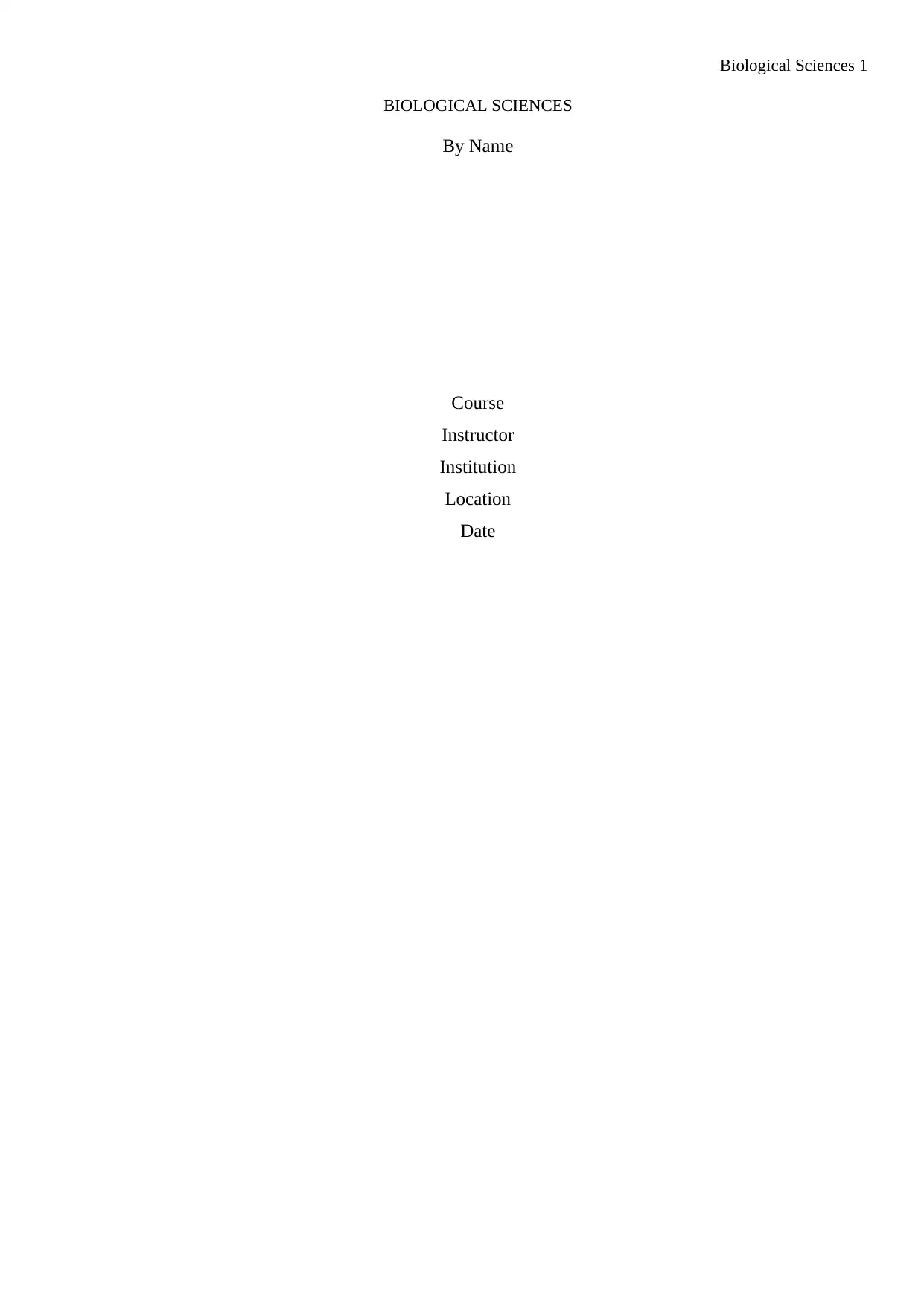
Biological Sciences 1
BIOLOGICAL SCIENCES
By Name
Course
Instructor
Institution
Location
Date
BIOLOGICAL SCIENCES
By Name
Course
Instructor
Institution
Location
Date
Paraphrase This Document
Need a fresh take? Get an instant paraphrase of this document with our AI Paraphraser
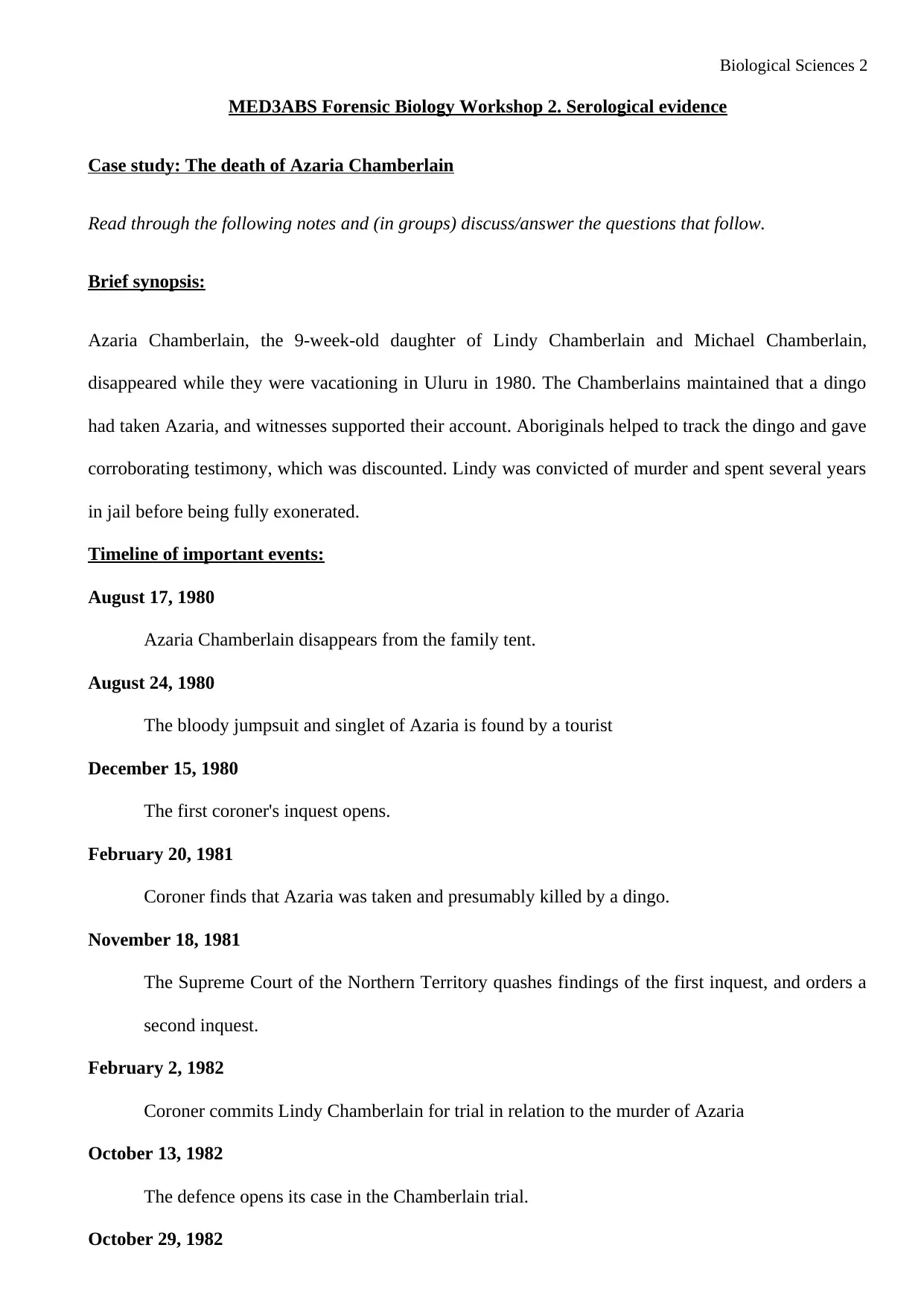
Biological Sciences 2
MED3ABS Forensic Biology Workshop 2. Serological evidence
Case study: The death of Azaria Chamberlain
Read through the following notes and (in groups) discuss/answer the questions that follow.
Brief synopsis:
Azaria Chamberlain, the 9-week-old daughter of Lindy Chamberlain and Michael Chamberlain,
disappeared while they were vacationing in Uluru in 1980. The Chamberlains maintained that a dingo
had taken Azaria, and witnesses supported their account. Aboriginals helped to track the dingo and gave
corroborating testimony, which was discounted. Lindy was convicted of murder and spent several years
in jail before being fully exonerated.
Timeline of important events:
August 17, 1980
Azaria Chamberlain disappears from the family tent.
August 24, 1980
The bloody jumpsuit and singlet of Azaria is found by a tourist
December 15, 1980
The first coroner's inquest opens.
February 20, 1981
Coroner finds that Azaria was taken and presumably killed by a dingo.
November 18, 1981
The Supreme Court of the Northern Territory quashes findings of the first inquest, and orders a
second inquest.
February 2, 1982
Coroner commits Lindy Chamberlain for trial in relation to the murder of Azaria
October 13, 1982
The defence opens its case in the Chamberlain trial.
October 29, 1982
MED3ABS Forensic Biology Workshop 2. Serological evidence
Case study: The death of Azaria Chamberlain
Read through the following notes and (in groups) discuss/answer the questions that follow.
Brief synopsis:
Azaria Chamberlain, the 9-week-old daughter of Lindy Chamberlain and Michael Chamberlain,
disappeared while they were vacationing in Uluru in 1980. The Chamberlains maintained that a dingo
had taken Azaria, and witnesses supported their account. Aboriginals helped to track the dingo and gave
corroborating testimony, which was discounted. Lindy was convicted of murder and spent several years
in jail before being fully exonerated.
Timeline of important events:
August 17, 1980
Azaria Chamberlain disappears from the family tent.
August 24, 1980
The bloody jumpsuit and singlet of Azaria is found by a tourist
December 15, 1980
The first coroner's inquest opens.
February 20, 1981
Coroner finds that Azaria was taken and presumably killed by a dingo.
November 18, 1981
The Supreme Court of the Northern Territory quashes findings of the first inquest, and orders a
second inquest.
February 2, 1982
Coroner commits Lindy Chamberlain for trial in relation to the murder of Azaria
October 13, 1982
The defence opens its case in the Chamberlain trial.
October 29, 1982
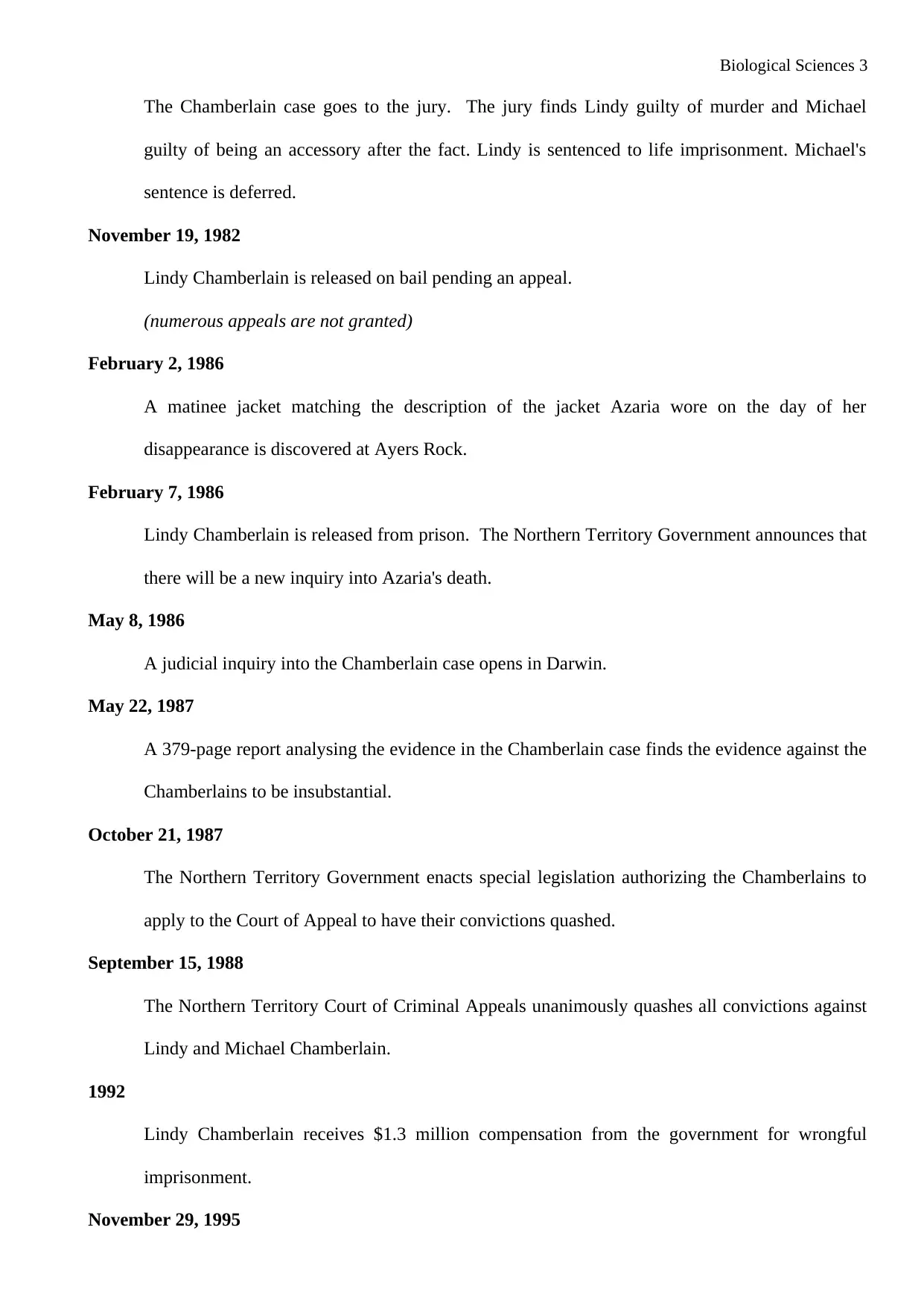
Biological Sciences 3
The Chamberlain case goes to the jury. The jury finds Lindy guilty of murder and Michael
guilty of being an accessory after the fact. Lindy is sentenced to life imprisonment. Michael's
sentence is deferred.
November 19, 1982
Lindy Chamberlain is released on bail pending an appeal.
(numerous appeals are not granted)
February 2, 1986
A matinee jacket matching the description of the jacket Azaria wore on the day of her
disappearance is discovered at Ayers Rock.
February 7, 1986
Lindy Chamberlain is released from prison. The Northern Territory Government announces that
there will be a new inquiry into Azaria's death.
May 8, 1986
A judicial inquiry into the Chamberlain case opens in Darwin.
May 22, 1987
A 379-page report analysing the evidence in the Chamberlain case finds the evidence against the
Chamberlains to be insubstantial.
October 21, 1987
The Northern Territory Government enacts special legislation authorizing the Chamberlains to
apply to the Court of Appeal to have their convictions quashed.
September 15, 1988
The Northern Territory Court of Criminal Appeals unanimously quashes all convictions against
Lindy and Michael Chamberlain.
1992
Lindy Chamberlain receives $1.3 million compensation from the government for wrongful
imprisonment.
November 29, 1995
The Chamberlain case goes to the jury. The jury finds Lindy guilty of murder and Michael
guilty of being an accessory after the fact. Lindy is sentenced to life imprisonment. Michael's
sentence is deferred.
November 19, 1982
Lindy Chamberlain is released on bail pending an appeal.
(numerous appeals are not granted)
February 2, 1986
A matinee jacket matching the description of the jacket Azaria wore on the day of her
disappearance is discovered at Ayers Rock.
February 7, 1986
Lindy Chamberlain is released from prison. The Northern Territory Government announces that
there will be a new inquiry into Azaria's death.
May 8, 1986
A judicial inquiry into the Chamberlain case opens in Darwin.
May 22, 1987
A 379-page report analysing the evidence in the Chamberlain case finds the evidence against the
Chamberlains to be insubstantial.
October 21, 1987
The Northern Territory Government enacts special legislation authorizing the Chamberlains to
apply to the Court of Appeal to have their convictions quashed.
September 15, 1988
The Northern Territory Court of Criminal Appeals unanimously quashes all convictions against
Lindy and Michael Chamberlain.
1992
Lindy Chamberlain receives $1.3 million compensation from the government for wrongful
imprisonment.
November 29, 1995
⊘ This is a preview!⊘
Do you want full access?
Subscribe today to unlock all pages.

Trusted by 1+ million students worldwide
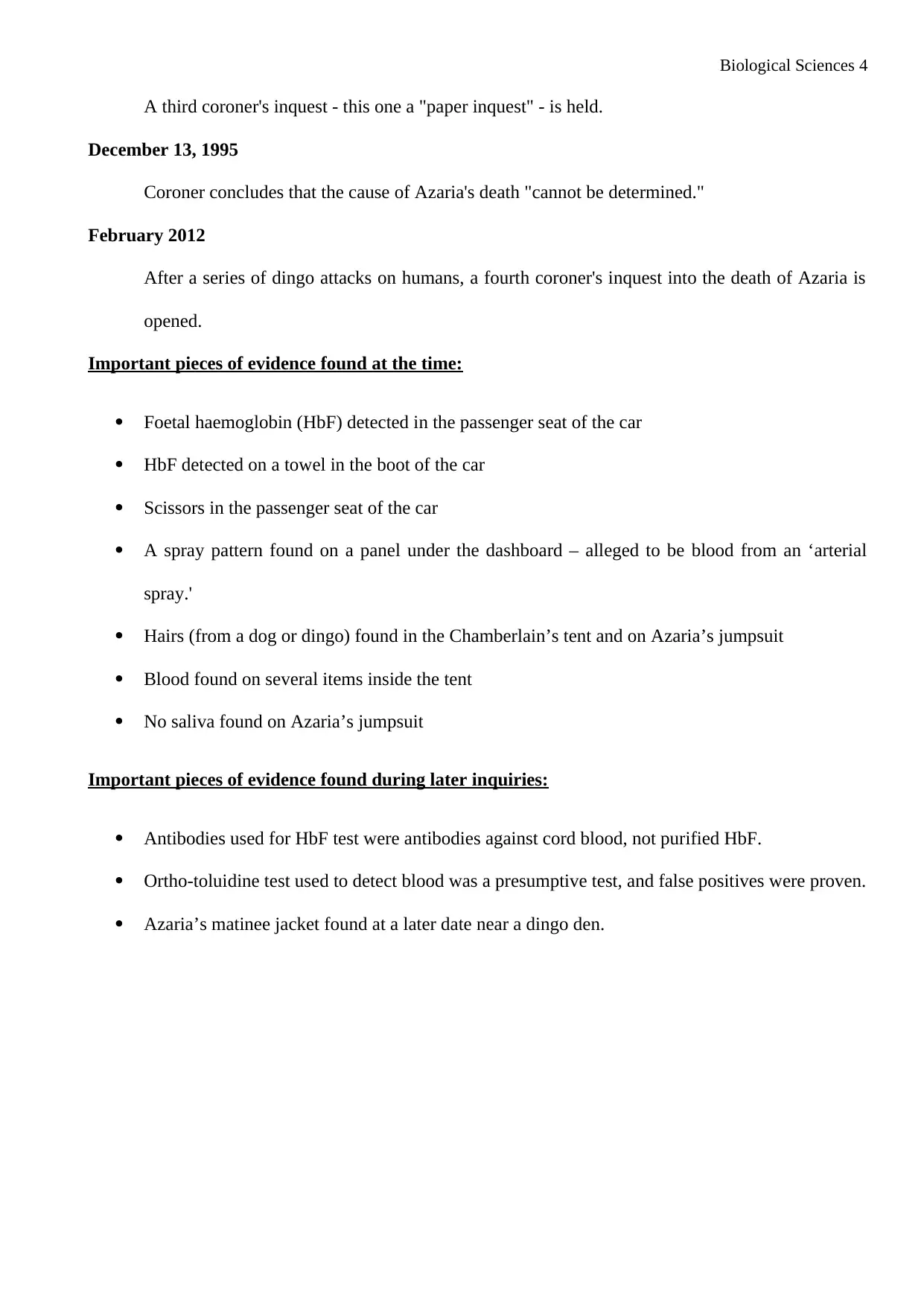
Biological Sciences 4
A third coroner's inquest - this one a "paper inquest" - is held.
December 13, 1995
Coroner concludes that the cause of Azaria's death "cannot be determined."
February 2012
After a series of dingo attacks on humans, a fourth coroner's inquest into the death of Azaria is
opened.
Important pieces of evidence found at the time:
Foetal haemoglobin (HbF) detected in the passenger seat of the car
HbF detected on a towel in the boot of the car
Scissors in the passenger seat of the car
A spray pattern found on a panel under the dashboard – alleged to be blood from an ‘arterial
spray.'
Hairs (from a dog or dingo) found in the Chamberlain’s tent and on Azaria’s jumpsuit
Blood found on several items inside the tent
No saliva found on Azaria’s jumpsuit
Important pieces of evidence found during later inquiries:
Antibodies used for HbF test were antibodies against cord blood, not purified HbF.
Ortho-toluidine test used to detect blood was a presumptive test, and false positives were proven.
Azaria’s matinee jacket found at a later date near a dingo den.
A third coroner's inquest - this one a "paper inquest" - is held.
December 13, 1995
Coroner concludes that the cause of Azaria's death "cannot be determined."
February 2012
After a series of dingo attacks on humans, a fourth coroner's inquest into the death of Azaria is
opened.
Important pieces of evidence found at the time:
Foetal haemoglobin (HbF) detected in the passenger seat of the car
HbF detected on a towel in the boot of the car
Scissors in the passenger seat of the car
A spray pattern found on a panel under the dashboard – alleged to be blood from an ‘arterial
spray.'
Hairs (from a dog or dingo) found in the Chamberlain’s tent and on Azaria’s jumpsuit
Blood found on several items inside the tent
No saliva found on Azaria’s jumpsuit
Important pieces of evidence found during later inquiries:
Antibodies used for HbF test were antibodies against cord blood, not purified HbF.
Ortho-toluidine test used to detect blood was a presumptive test, and false positives were proven.
Azaria’s matinee jacket found at a later date near a dingo den.
Paraphrase This Document
Need a fresh take? Get an instant paraphrase of this document with our AI Paraphraser
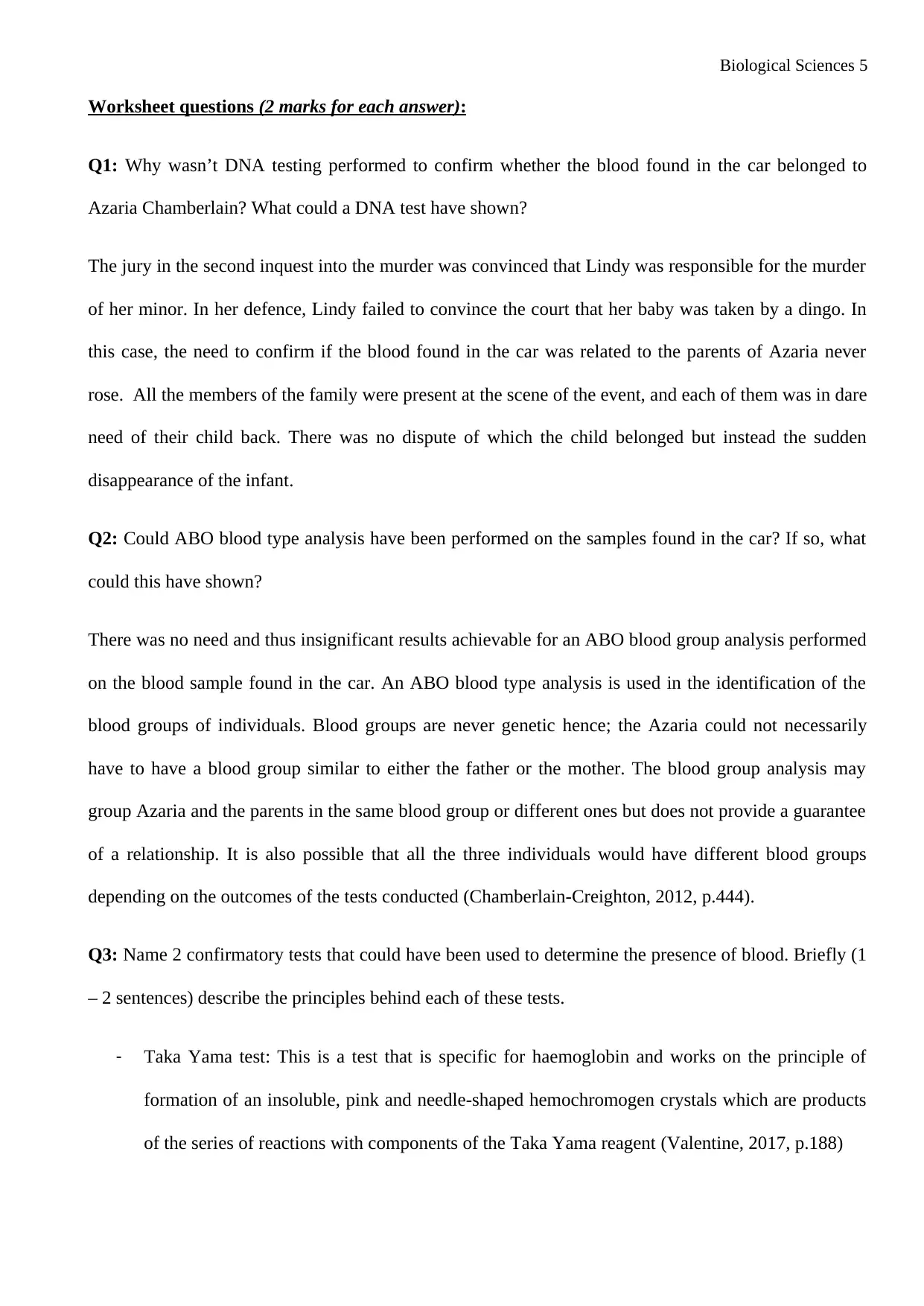
Biological Sciences 5
Worksheet questions (2 marks for each answer):
Q1: Why wasn’t DNA testing performed to confirm whether the blood found in the car belonged to
Azaria Chamberlain? What could a DNA test have shown?
The jury in the second inquest into the murder was convinced that Lindy was responsible for the murder
of her minor. In her defence, Lindy failed to convince the court that her baby was taken by a dingo. In
this case, the need to confirm if the blood found in the car was related to the parents of Azaria never
rose. All the members of the family were present at the scene of the event, and each of them was in dare
need of their child back. There was no dispute of which the child belonged but instead the sudden
disappearance of the infant.
Q2: Could ABO blood type analysis have been performed on the samples found in the car? If so, what
could this have shown?
There was no need and thus insignificant results achievable for an ABO blood group analysis performed
on the blood sample found in the car. An ABO blood type analysis is used in the identification of the
blood groups of individuals. Blood groups are never genetic hence; the Azaria could not necessarily
have to have a blood group similar to either the father or the mother. The blood group analysis may
group Azaria and the parents in the same blood group or different ones but does not provide a guarantee
of a relationship. It is also possible that all the three individuals would have different blood groups
depending on the outcomes of the tests conducted (Chamberlain-Creighton, 2012, p.444).
Q3: Name 2 confirmatory tests that could have been used to determine the presence of blood. Briefly (1
– 2 sentences) describe the principles behind each of these tests.
- Taka Yama test: This is a test that is specific for haemoglobin and works on the principle of
formation of an insoluble, pink and needle-shaped hemochromogen crystals which are products
of the series of reactions with components of the Taka Yama reagent (Valentine, 2017, p.188)
Worksheet questions (2 marks for each answer):
Q1: Why wasn’t DNA testing performed to confirm whether the blood found in the car belonged to
Azaria Chamberlain? What could a DNA test have shown?
The jury in the second inquest into the murder was convinced that Lindy was responsible for the murder
of her minor. In her defence, Lindy failed to convince the court that her baby was taken by a dingo. In
this case, the need to confirm if the blood found in the car was related to the parents of Azaria never
rose. All the members of the family were present at the scene of the event, and each of them was in dare
need of their child back. There was no dispute of which the child belonged but instead the sudden
disappearance of the infant.
Q2: Could ABO blood type analysis have been performed on the samples found in the car? If so, what
could this have shown?
There was no need and thus insignificant results achievable for an ABO blood group analysis performed
on the blood sample found in the car. An ABO blood type analysis is used in the identification of the
blood groups of individuals. Blood groups are never genetic hence; the Azaria could not necessarily
have to have a blood group similar to either the father or the mother. The blood group analysis may
group Azaria and the parents in the same blood group or different ones but does not provide a guarantee
of a relationship. It is also possible that all the three individuals would have different blood groups
depending on the outcomes of the tests conducted (Chamberlain-Creighton, 2012, p.444).
Q3: Name 2 confirmatory tests that could have been used to determine the presence of blood. Briefly (1
– 2 sentences) describe the principles behind each of these tests.
- Taka Yama test: This is a test that is specific for haemoglobin and works on the principle of
formation of an insoluble, pink and needle-shaped hemochromogen crystals which are products
of the series of reactions with components of the Taka Yama reagent (Valentine, 2017, p.188)
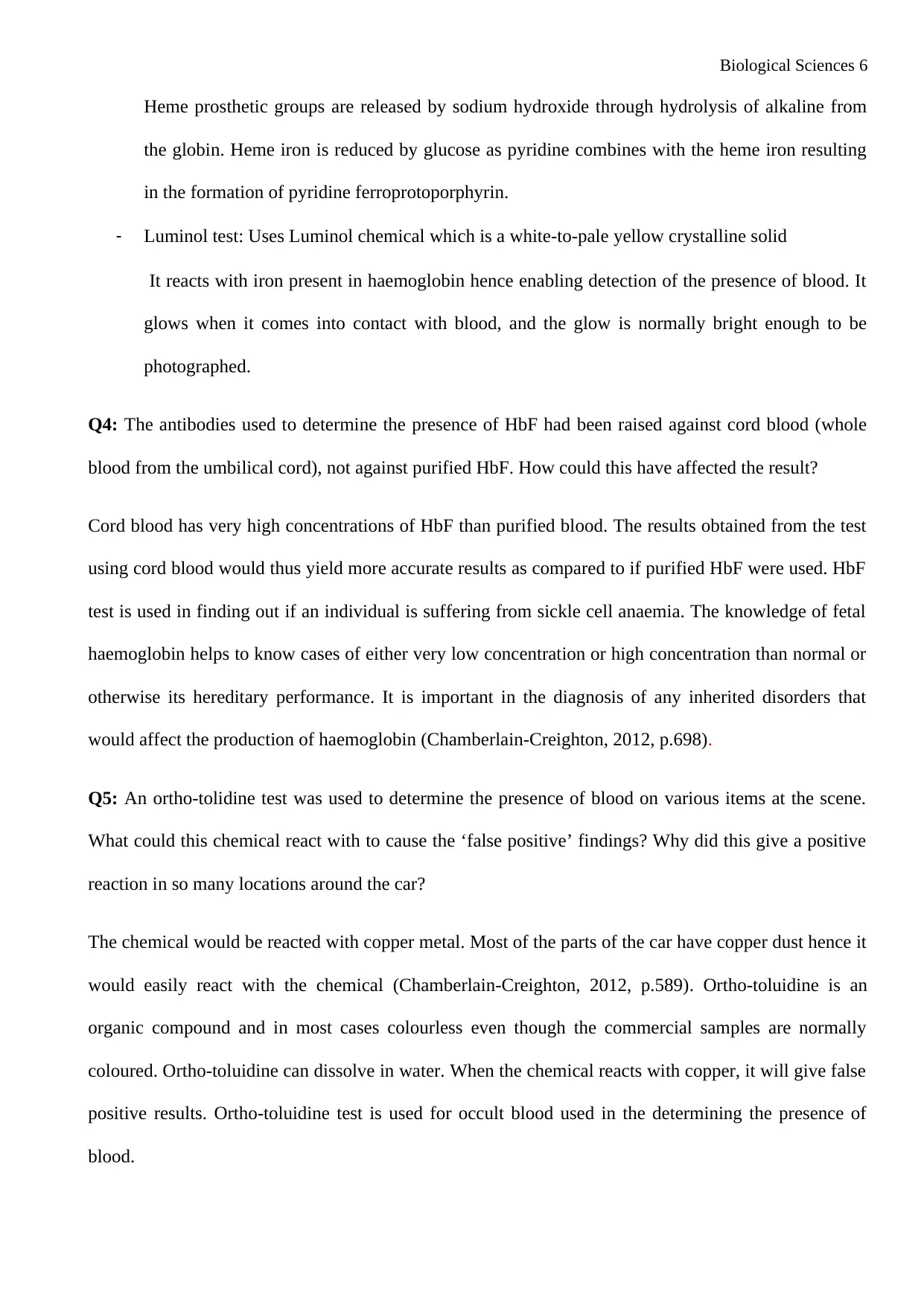
Biological Sciences 6
Heme prosthetic groups are released by sodium hydroxide through hydrolysis of alkaline from
the globin. Heme iron is reduced by glucose as pyridine combines with the heme iron resulting
in the formation of pyridine ferroprotoporphyrin.
- Luminol test: Uses Luminol chemical which is a white-to-pale yellow crystalline solid
It reacts with iron present in haemoglobin hence enabling detection of the presence of blood. It
glows when it comes into contact with blood, and the glow is normally bright enough to be
photographed.
Q4: The antibodies used to determine the presence of HbF had been raised against cord blood (whole
blood from the umbilical cord), not against purified HbF. How could this have affected the result?
Cord blood has very high concentrations of HbF than purified blood. The results obtained from the test
using cord blood would thus yield more accurate results as compared to if purified HbF were used. HbF
test is used in finding out if an individual is suffering from sickle cell anaemia. The knowledge of fetal
haemoglobin helps to know cases of either very low concentration or high concentration than normal or
otherwise its hereditary performance. It is important in the diagnosis of any inherited disorders that
would affect the production of haemoglobin (Chamberlain-Creighton, 2012, p.698).
Q5: An ortho-tolidine test was used to determine the presence of blood on various items at the scene.
What could this chemical react with to cause the ‘false positive’ findings? Why did this give a positive
reaction in so many locations around the car?
The chemical would be reacted with copper metal. Most of the parts of the car have copper dust hence it
would easily react with the chemical (Chamberlain-Creighton, 2012, p.589). Ortho-toluidine is an
organic compound and in most cases colourless even though the commercial samples are normally
coloured. Ortho-toluidine can dissolve in water. When the chemical reacts with copper, it will give false
positive results. Ortho-toluidine test is used for occult blood used in the determining the presence of
blood.
Heme prosthetic groups are released by sodium hydroxide through hydrolysis of alkaline from
the globin. Heme iron is reduced by glucose as pyridine combines with the heme iron resulting
in the formation of pyridine ferroprotoporphyrin.
- Luminol test: Uses Luminol chemical which is a white-to-pale yellow crystalline solid
It reacts with iron present in haemoglobin hence enabling detection of the presence of blood. It
glows when it comes into contact with blood, and the glow is normally bright enough to be
photographed.
Q4: The antibodies used to determine the presence of HbF had been raised against cord blood (whole
blood from the umbilical cord), not against purified HbF. How could this have affected the result?
Cord blood has very high concentrations of HbF than purified blood. The results obtained from the test
using cord blood would thus yield more accurate results as compared to if purified HbF were used. HbF
test is used in finding out if an individual is suffering from sickle cell anaemia. The knowledge of fetal
haemoglobin helps to know cases of either very low concentration or high concentration than normal or
otherwise its hereditary performance. It is important in the diagnosis of any inherited disorders that
would affect the production of haemoglobin (Chamberlain-Creighton, 2012, p.698).
Q5: An ortho-tolidine test was used to determine the presence of blood on various items at the scene.
What could this chemical react with to cause the ‘false positive’ findings? Why did this give a positive
reaction in so many locations around the car?
The chemical would be reacted with copper metal. Most of the parts of the car have copper dust hence it
would easily react with the chemical (Chamberlain-Creighton, 2012, p.589). Ortho-toluidine is an
organic compound and in most cases colourless even though the commercial samples are normally
coloured. Ortho-toluidine can dissolve in water. When the chemical reacts with copper, it will give false
positive results. Ortho-toluidine test is used for occult blood used in the determining the presence of
blood.
⊘ This is a preview!⊘
Do you want full access?
Subscribe today to unlock all pages.

Trusted by 1+ million students worldwide

Biological Sciences 7
Q6: Explain the alleged “blood splatter” under a panel of the dashboard. Comment on the accuracy of
reporting this as possible blood splatter. The dingo might have carried away Azaria away under the
panel of the dashboard where it attacked it destroying some of the blood vessels. This would be the
cause of the observed blood spatter under the panel (Valentine, 2017, p.158). Upon the analysis of the
case by the various courts in which it was finally deduced that the parents of Azaria were not in any way
linked to the murder of their child, it would be more reliable to conclude this reporting as a possible
blood spatter. The dingo might have attacked Azaria and torn off her skin causing her severe body
injury that would even culminate into deep cuts into the body. The deep cuts would get to the arteries
and veins thereby resulting in arterial spray hence a justification of the possibility of blood spatter.
Q6: Explain the alleged “blood splatter” under a panel of the dashboard. Comment on the accuracy of
reporting this as possible blood splatter. The dingo might have carried away Azaria away under the
panel of the dashboard where it attacked it destroying some of the blood vessels. This would be the
cause of the observed blood spatter under the panel (Valentine, 2017, p.158). Upon the analysis of the
case by the various courts in which it was finally deduced that the parents of Azaria were not in any way
linked to the murder of their child, it would be more reliable to conclude this reporting as a possible
blood spatter. The dingo might have attacked Azaria and torn off her skin causing her severe body
injury that would even culminate into deep cuts into the body. The deep cuts would get to the arteries
and veins thereby resulting in arterial spray hence a justification of the possibility of blood spatter.
Paraphrase This Document
Need a fresh take? Get an instant paraphrase of this document with our AI Paraphraser
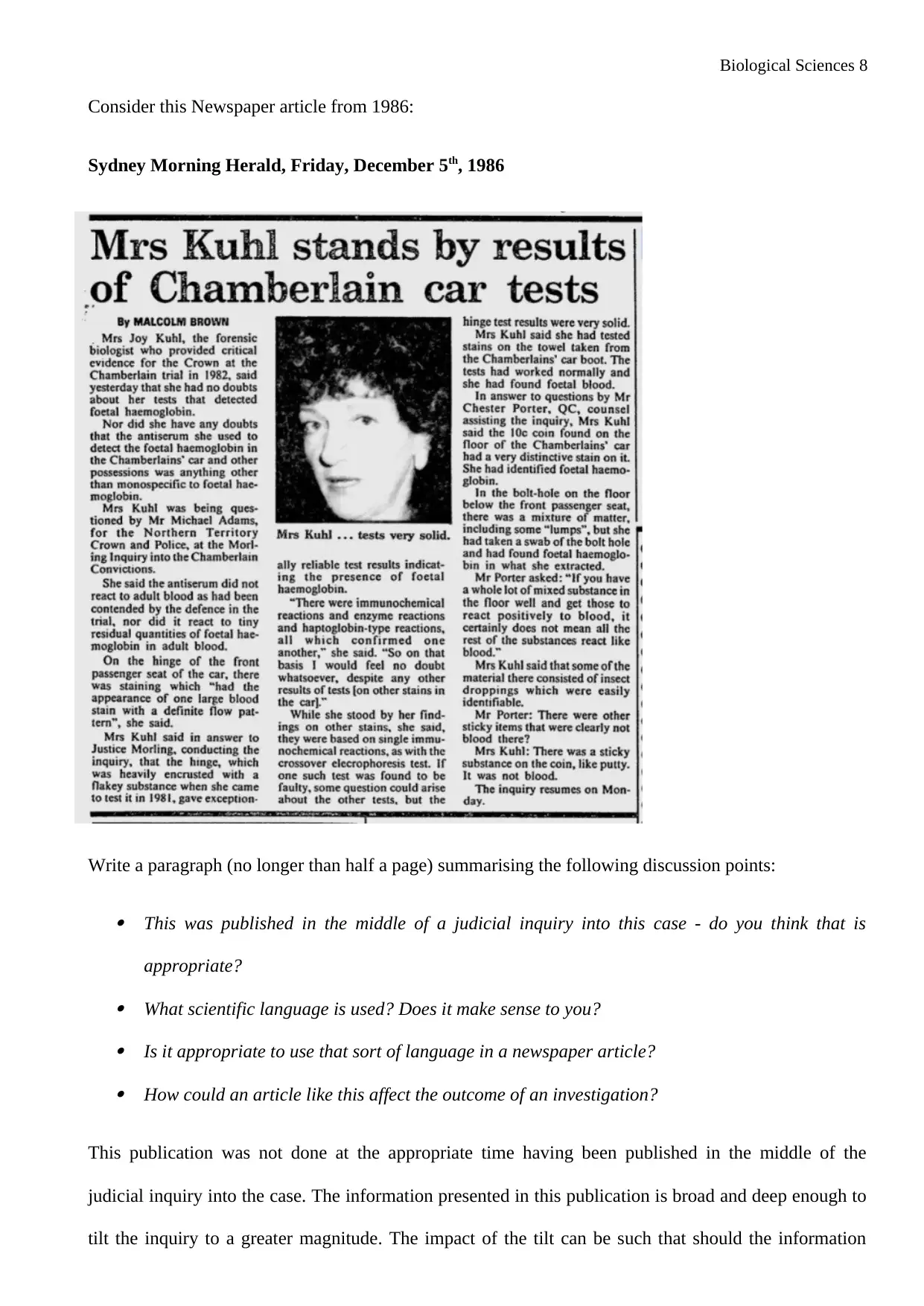
Biological Sciences 8
Consider this Newspaper article from 1986:
Sydney Morning Herald, Friday, December 5th, 1986
Write a paragraph (no longer than half a page) summarising the following discussion points:
This was published in the middle of a judicial inquiry into this case - do you think that is
appropriate?
What scientific language is used? Does it make sense to you?
Is it appropriate to use that sort of language in a newspaper article?
How could an article like this affect the outcome of an investigation?
This publication was not done at the appropriate time having been published in the middle of the
judicial inquiry into the case. The information presented in this publication is broad and deep enough to
tilt the inquiry to a greater magnitude. The impact of the tilt can be such that should the information
Consider this Newspaper article from 1986:
Sydney Morning Herald, Friday, December 5th, 1986
Write a paragraph (no longer than half a page) summarising the following discussion points:
This was published in the middle of a judicial inquiry into this case - do you think that is
appropriate?
What scientific language is used? Does it make sense to you?
Is it appropriate to use that sort of language in a newspaper article?
How could an article like this affect the outcome of an investigation?
This publication was not done at the appropriate time having been published in the middle of the
judicial inquiry into the case. The information presented in this publication is broad and deep enough to
tilt the inquiry to a greater magnitude. The impact of the tilt can be such that should the information
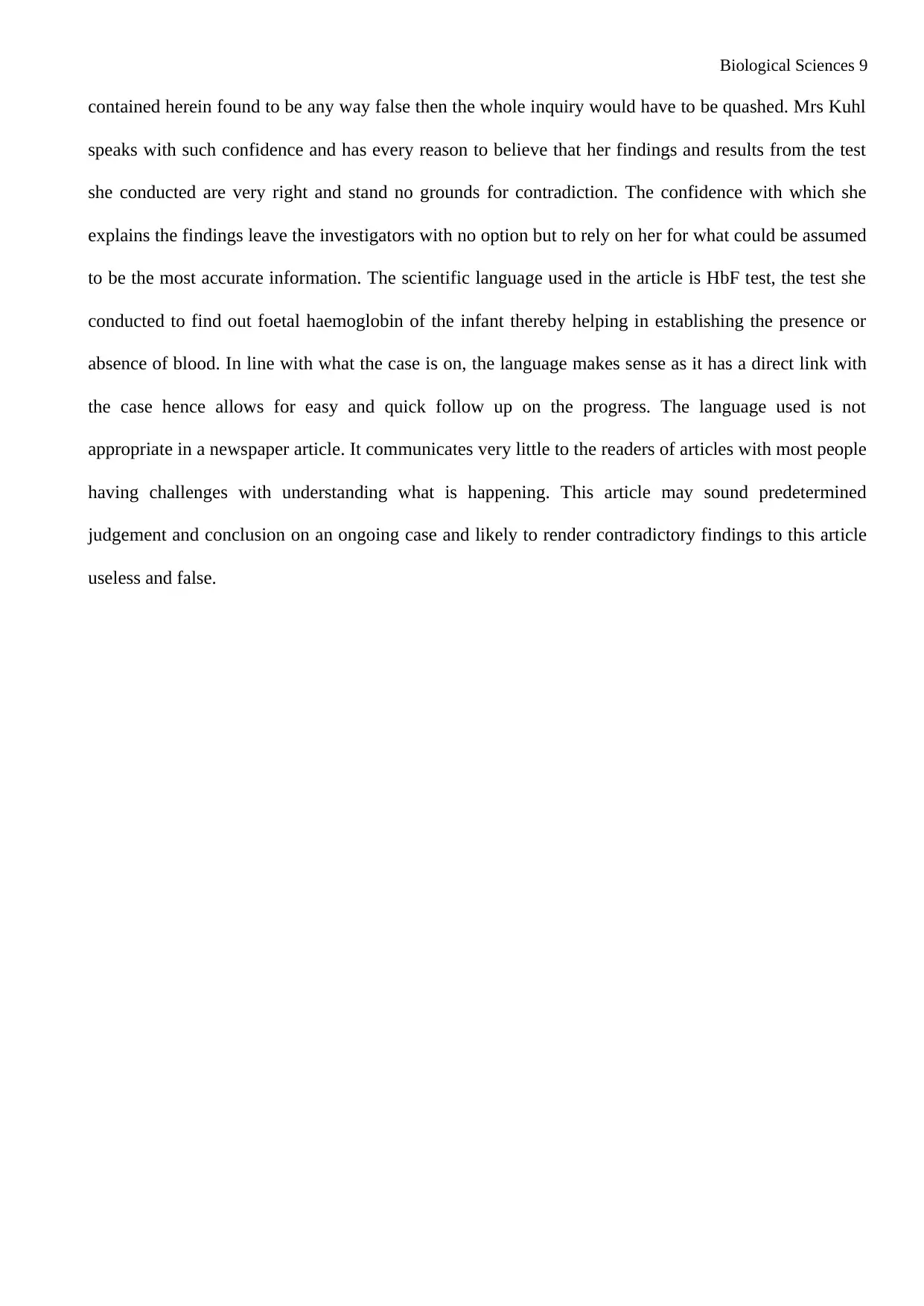
Biological Sciences 9
contained herein found to be any way false then the whole inquiry would have to be quashed. Mrs Kuhl
speaks with such confidence and has every reason to believe that her findings and results from the test
she conducted are very right and stand no grounds for contradiction. The confidence with which she
explains the findings leave the investigators with no option but to rely on her for what could be assumed
to be the most accurate information. The scientific language used in the article is HbF test, the test she
conducted to find out foetal haemoglobin of the infant thereby helping in establishing the presence or
absence of blood. In line with what the case is on, the language makes sense as it has a direct link with
the case hence allows for easy and quick follow up on the progress. The language used is not
appropriate in a newspaper article. It communicates very little to the readers of articles with most people
having challenges with understanding what is happening. This article may sound predetermined
judgement and conclusion on an ongoing case and likely to render contradictory findings to this article
useless and false.
contained herein found to be any way false then the whole inquiry would have to be quashed. Mrs Kuhl
speaks with such confidence and has every reason to believe that her findings and results from the test
she conducted are very right and stand no grounds for contradiction. The confidence with which she
explains the findings leave the investigators with no option but to rely on her for what could be assumed
to be the most accurate information. The scientific language used in the article is HbF test, the test she
conducted to find out foetal haemoglobin of the infant thereby helping in establishing the presence or
absence of blood. In line with what the case is on, the language makes sense as it has a direct link with
the case hence allows for easy and quick follow up on the progress. The language used is not
appropriate in a newspaper article. It communicates very little to the readers of articles with most people
having challenges with understanding what is happening. This article may sound predetermined
judgement and conclusion on an ongoing case and likely to render contradictory findings to this article
useless and false.
⊘ This is a preview!⊘
Do you want full access?
Subscribe today to unlock all pages.

Trusted by 1+ million students worldwide
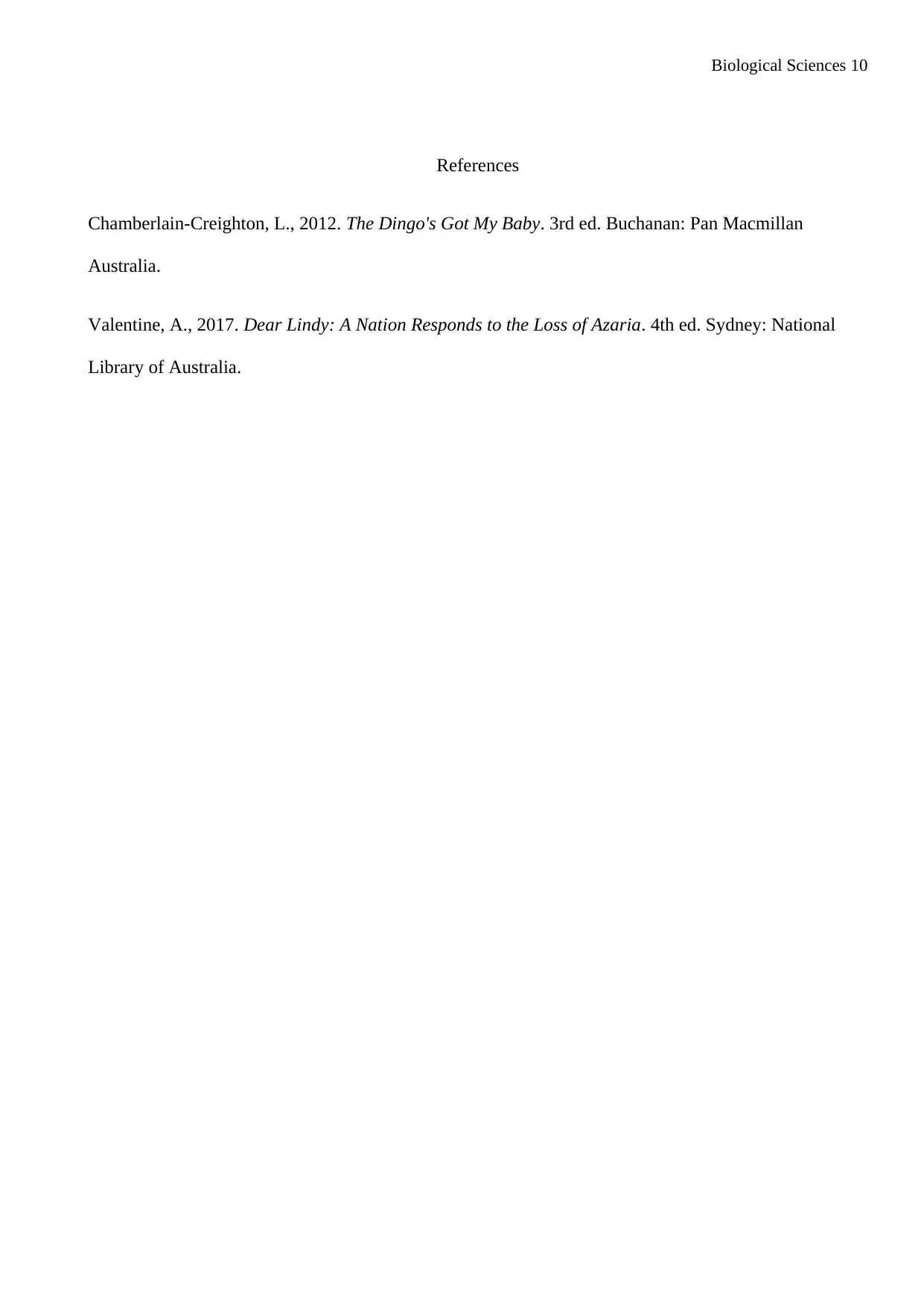
Biological Sciences 10
References
Chamberlain-Creighton, L., 2012. The Dingo's Got My Baby. 3rd ed. Buchanan: Pan Macmillan
Australia.
Valentine, A., 2017. Dear Lindy: A Nation Responds to the Loss of Azaria. 4th ed. Sydney: National
Library of Australia.
References
Chamberlain-Creighton, L., 2012. The Dingo's Got My Baby. 3rd ed. Buchanan: Pan Macmillan
Australia.
Valentine, A., 2017. Dear Lindy: A Nation Responds to the Loss of Azaria. 4th ed. Sydney: National
Library of Australia.
1 out of 10
Your All-in-One AI-Powered Toolkit for Academic Success.
+13062052269
info@desklib.com
Available 24*7 on WhatsApp / Email
![[object Object]](/_next/static/media/star-bottom.7253800d.svg)
Unlock your academic potential
Copyright © 2020–2025 A2Z Services. All Rights Reserved. Developed and managed by ZUCOL.

